A Guide to Understand Fish with Diagram
As fish are marine creatures, their body functions are much different from mammals. To understand marine animals, their body functions, it is a must to learn their anatomy. For that, the students can use fish anatomy diagrams. To have a high-quality diagram for their lessons and projects, the students must use the EdrawMax Online tool.
1. The Fish Anatomy
For discussing the fish anatomy of a fish, it is important to segregate it into three parts. People believe only the outer body features, size, and color of the body can be different. However, that is not true. The internal mechanisms and features of some species can be different too. It is important to know the following anatomical position terms to discuss the anatomy of the fish:
- Anterior: Closer to the head
- Posterior: Closer to the tail
- Dorsal: back/ top
- Ventral: front/ bottom
- Lateral: side of the fish body
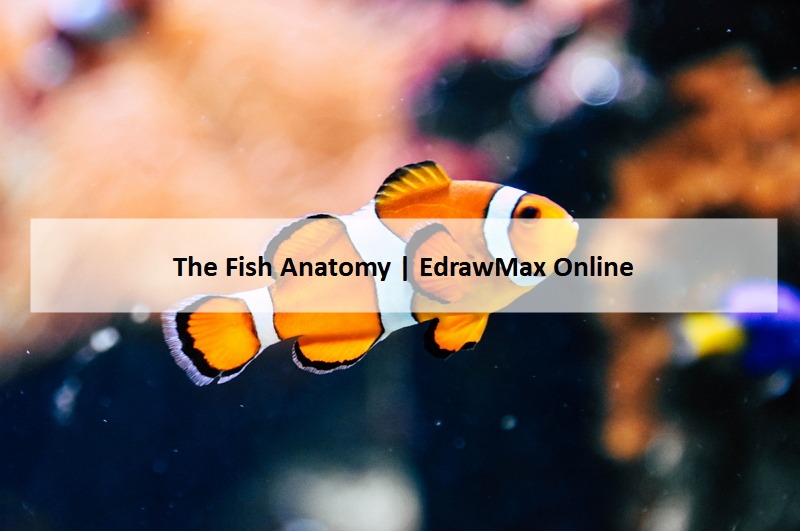
1.1 The Fish External Anatomy
Fish are vertebrates, which means they have vertebrae. All fish have fins, and most have scales. In addition, fish are cold-blooded animals that lay eggs and are very suitable for living in water.
- Eyes: It is for short sight, can help in detecting colors.
- Nares: Helps in smelling.
- Mouth: At the front part for food consumption.
- Operculum: Bony cover on the gills, it allows the water to pass on the gills.
- Pectoral fin: Helps in side-to-side movement and regulation of speed.
- Pelvic Fin: Stabilize while swimming, and helps in up-down movements.
- Vent: It is an outlet for eggs and sperms during mating season and also a medium for waste elimination.
- Anal Fin: It gives stability while swimming.
- Caudal Fin: It works as a propeller and helps to move a fish in the water
- Adipose Fin: A small and thick fin is present between the dorsal and caudal fin, and it may or may not present in a fish.
- Dorsal Fin: Helps in balancing while swimming
- Scales: It prevents the fish from getting injured
- Barbels: Whiskers present in the head area. In some cases, it acts as sensory organs.
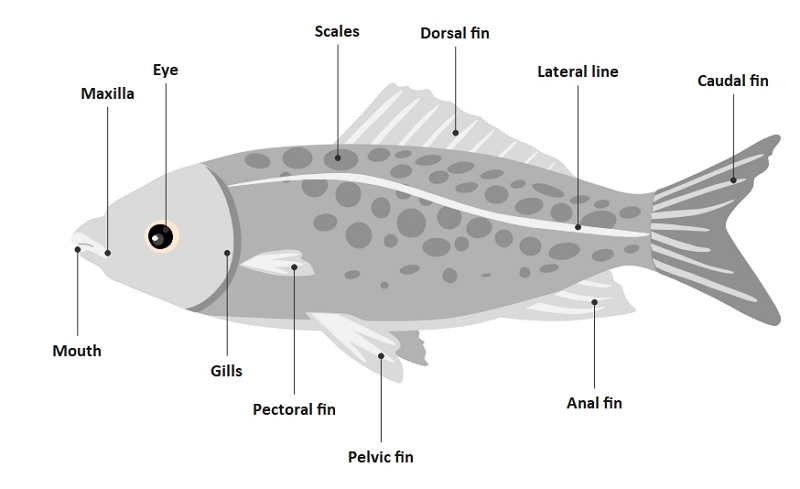 Source:EdrawMax Online
Source:EdrawMax Online
1.2 The Fish Internal Anatomy
Spine:
- Primary framework made of vertebrae
- Protects the spinal cord
Spinal cord:
- It takes the sensory information from the fish body to the brain and similarly carries back the data from the brain to the body.
- A connector between the brain and the rest of the body
Brain:
- Processes the sensory inputs
- Controls the respiration and other automatic functions
Lateral line:
- A sensory organ that helps to decide their direction
- Determine the vibrations under the water
Swim bladder:
- They are gas-filled organs to maintain buoyancy
- Maintains atmospheric pressure while going up and down the water-level
Gills:
- Help in under-water breathing
Kidney:
- Regulates water and salt concentration of the body for a fish to stay either in saltwater or freshwater.
- It takes out the waste materials from the blood.
Stomach and Intestines:
- Helps in digestion and absorption of nutrients
- The herbivorous have longer intestines than the piscivorous for the breakdown of fibrous food.
Pyloric caeca:
- They look like fingers.
- Their function is unknown. However, researchers say that they help in the absorption of nutrients from digested food.
Liver:
- Stores fats and carbohydrates
- Secrets fat-digesting enzymes
- Removes the old blood cells from the stream
- Elimination of nitrogenous wastes
Heart:
- It circulates oxygen and nutrient-rich blood to different organs.
- It takes waste products to the liver and kidney for excretion.
Muscle:
- The fleshy part helps to prepare the fillet of the fish.
- It helps them to move and go from one place to another.
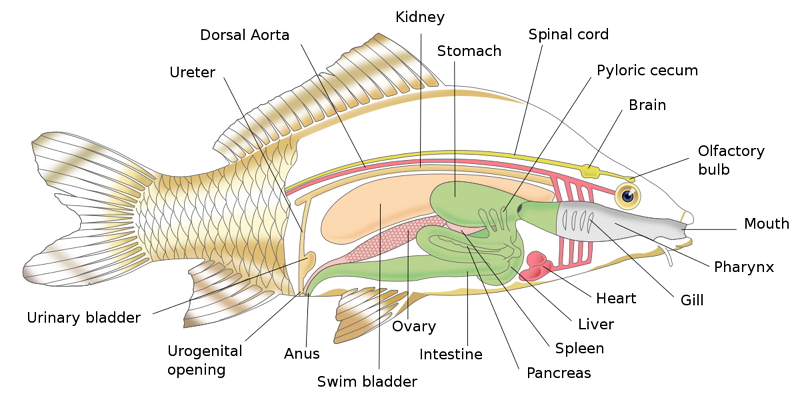
1.3 The Fish Reproductive Anatomy
For reproduction, fishes have testes and ovaries. The gonads are similarly shaped and stay in a partially or entirely fused state. The fleshy genital papilla present behind the anus can determine the sex of the fish.
Testes:
- For most species, male fishes have a pair of testes of the same size.
- Most of the fishes have a spherical structure, namely sperm ampullae. They grow and ripen during the breeding season, and as the season ends, they get absorbed in the body again.
Ovaries:
- Most female fishes have a pair of ovaries.
- Fish ovaries are of three types, gymnovarian, secondary gymnovarian, and cyst ovarian.
- For gymnovarian ovaries, oocytes are released in the coelomic cavity to enter the ostium. In the case of secondary gymnovarian ovaries, ova goes to coelom and then oviduct. In cyst ovarian ovaries, the ovary lumen is continued to the oviduct.
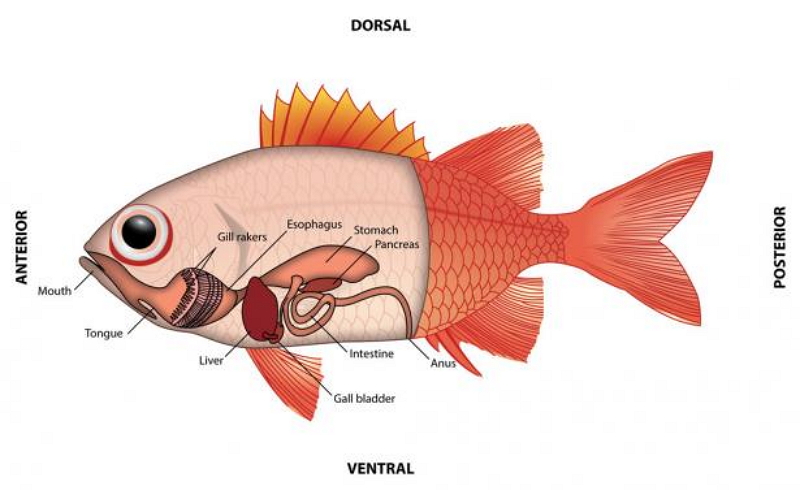
3. How to Draw the Fish Anatomy
To learn the fish anatomy, the students must use the fish anatomy diagrams. To create a fish anatomy diagram, they can follow these steps:
3.1 How to Create Fish Anatomy Diagram from Sketch
Creating such a diagram by hand can be difficult. The students can follow these steps to make their fish anatomy diagram:
Step 1: Draw two curved lines with the middle part swollen to create a hollow section. Create a pointed front part, and draw the fish’s mouth at this portion.
Step 2: The end part is divergent and curvy, and a slightly curved line joins them. The students can draw some thin lines parallel to each other to draw the tail of the fish.

Step 3: They have to draw a fin on the top part of the fish. It is the spiny dorsal fin. After leaving a small gap at the end, create another fin. It is the soft dorsal fin.

Step 4: A dotted line is drawn joining the head to tail, known as the lateral line. Under the lateral line and at the end of the operculum, draw the pectoral fin.
Step 5: The pelvic fin is present at the ventral part, the parallel position of the spiny dorsal fin.

Step 6: Now, draw the Anal fin, which is there, at the ventral part, parallel to the soft dorsal fin.
Step 7: Draw a small curve after leaving a few inches from the fish mouth to create the operculum. Now draw the eyes at the upper portion of the mouth.

3.2 How to Create Fish Anatomy Diagram Online
However, creating fish anatomy diagrams by hand can be difficult, and hence the students must use the EdrawMax Online tool to create a good quality diagram. Here are a few simple steps which they can follow to make the diagram:
Step 1: EdrawMax Online is a user-friendly tool, and it is effortless to work on it. To start the work, the students need to open it and then open New . They can look for the Science and Education option. There are several diagrams which they can use for their lessons.
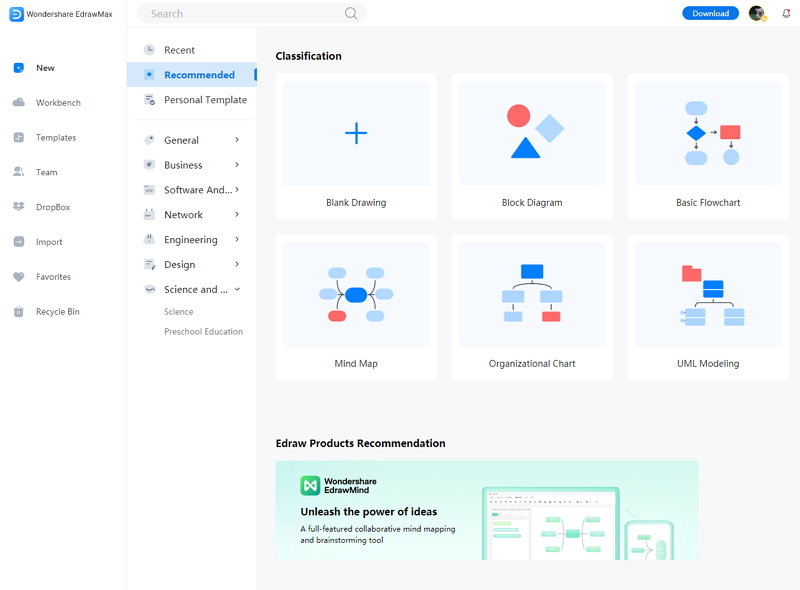
Step 2: They have to find the Biology tab. Here the students can locate the fish anatomy diagram. They can edit the image as per their requirements. They can use it for their lessons or projects and dissertation papers.
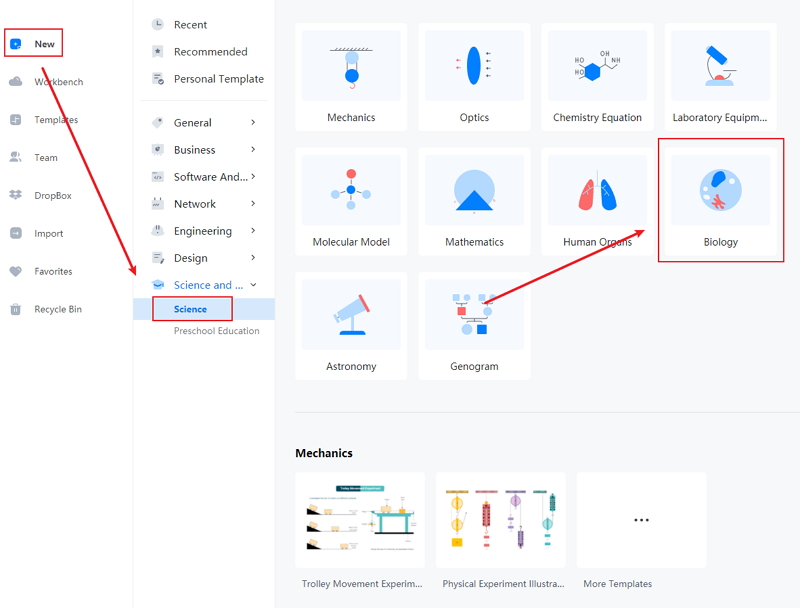
Step 3: After selecting the template they require, the students should modify it as per their choice. The tool gives the students some hassle-free options to edit their diagrams. They can work on those images according to their preference to create a high-quality fisn anatomy image.
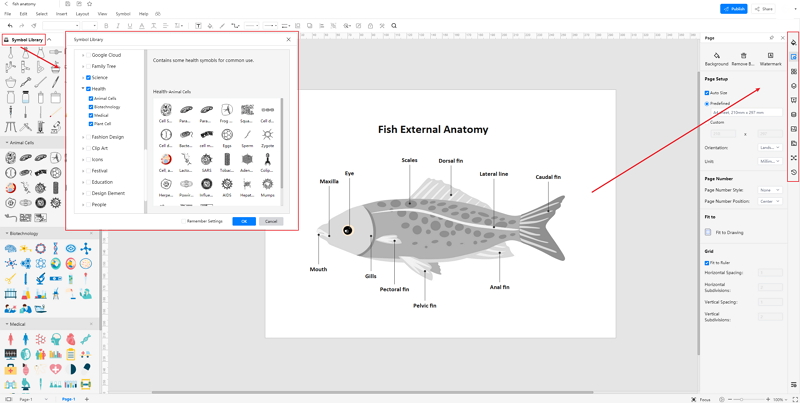
Step 4: Once the student finishes their diagram, they can save it in different formats. They can also export the file to use it in their papers and projects.
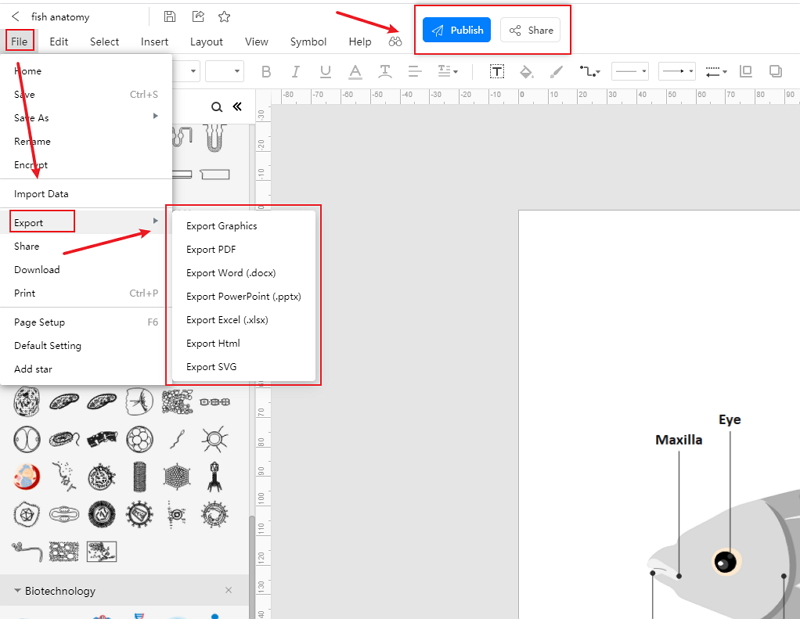
4. The Physical Characteristics of Fish
4.1 Fish Body Temperature
Fishes are cold-blooded, and they have the temperature of the water surrounding them. Different species of fish have different ranges of temperature in which they survive. This temperature is primarily dependent on the water where the species originated or its natural habitat. If a fish is living in an aquarium having a temperature different from the temperature where they conventionally survive, it can die; as they do not have a body temperature regulation mechanism.
4.2 How Do Fish Breathe
Gills in fish regulate the breathing process in them. They absorb oxygen from the oxygenated water for breathing. Gills look like leaves, and there are four on each side hidden by an operculum of bony gill cover. The gills have blood vessels that can take the oxygen from the water the fishes swallow from the mouth. The water passes over the gills and leaves by the operculum. This process depends on the need for oxygen for the fish and the density of oxygen in the water.
4.3 The Classification of Fishes:
Bighead Sea Robin:
- White ventral side
- Yellow and blackish dorsal and lateral sides
- Expanded pectoral fin during swimming
- Three spines on the pectoral fin for walking on the seafloor also work as sensory organs.
Atlantic Croaker:
- White ventral side
- Silver or greyish dorsal side
- A dark spot at the junction of the body and pectoral fin
- The lateral line starts at the operculum and goes to posterior
Seatrout:
- White ventral side with spots
- Blue dorsal side
- It has a big mouth with a pair of sharp teeth
Least Puffer:
- White ventral side
- Dark dorsal side
- Dorsal fin near the posterior part
- Smallmouth and eyes on the anterior side
5. Conclusion
Diagrams can help the students to have thorough ideas about the fish anatomy and their body functions. However, creating a fish anatomy diagram by hand can be difficult. Therefore, they must use the EdrawMax Online tool. The tool has an easy-to-use interface and can allow the students to create high-quality diagrams without any difficulty.
In conclusion, EdrawMax Online is a quick-start diagramming tool, which is easier to make fish diagram and any 280 types of diagrams. Also, it contains substantial built-in templates that you can use for free, or share your science diagrams with others in our template community.




